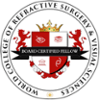Results After Laser Eye Surgery: Common Questions

When it comes to something as precious as our vision, it is only natural to be cautious and curious. At London Vision Clinic, we aim to provide as much information to our prospective patients regarding not only the procedure itself but also what they can expect after treatment. So, we put together this guide to answer the most common questions about Laser Eye Surgery results and recovery.
Take a look at the questions below to learn more.
The following is our recommended activity schedule for patients who have had LASIK (the most common Laser Eye Surgery procedure):
- Avoid any activity that could lead to something touching or poking your eyes.
- Rest and keep your eyes closed for the first few hours after surgery. Once things have settled, you can resume normal activity at home.
- Avoid rubbing your eyes. Instead, use lubricating eye drops for any itching or dryness.
24 hours after surgery
- Take a bath instead of a shower. Avoid getting any soap or tap water in your eyes.
- You can read and watch TV – but be careful not to let your eyes dry out.
- Most patients can return to work but you should continue to use your lubricating eye drops.
- Flying is usually acceptable but again, you will need to use your eye drops as the air is very dry in aeroplanes.
48 hours after surgery
- At this stage, the cornea has typically healed. This means that normal activities such as showering and wearing make-up are acceptable.
Day 3 activities
- You can take exercise that does not affect your eyes such as using a treadmill, or stationary bike, but not swimming.
- You can play with small children but be careful they do not poke you in your eye!
Week 2 activities
By week 2, most patients can resume their usual activities, including:
- Racquet sports, such as tennis, squash, racquetball, and badminton (but always wear eye protection);
- Swimming (with goggles);
- Scuba diving, snorkelling;
- Sailing;
- Motorcycling, dirt biking, mountain biking;
- Football;
- Skiing (with goggles)
However, we recommend avoiding high-impact sports such as martial arts, boxing and water skiing for at least one month after LASIK.
The above can be used as a general guide; however, it is important to note that everyone’s recovery is different. Your surgeon will advise you on when you can resume specific activities during your post-operative assessments.
Click here for more information on resuming sports and other activities after Laser Eye Surgery.
We still see many people who are still worried about the risk of going blind as a result of Laser Eye Surgery. While there is an exceedingly small risk of such an outcome, this is lower than the risk created by wearing monthly contact lenses for one year. In fact, Laser Eye Surgery is not considered one of the safest surgical procedures in the world thanks to its high success rate and low risk of serious complications.
Click here for more information and a video on this topic.
If you would like to watch a video relating to this FAQ please click here.
As noted above, recovery milestones can vary between patients. However, most patients have recovered sufficient (and much-improved) vision to enable them to drive within just a couple of days of their treatment. Your surgeon will be able to offer you more information and likely sign you off for getting behind the wheel at your post-operative appointment.
Click here for more information and a video on this topic.
Mr. Glenn Carp answers this question in a video – click here to watch it.
You can apply makeup 48 hours after surgery. However, we advise you not to apply eye makeup until 7 days after your surgery. Further, you must be careful not to rub your eyes when removing your eye makeup.
Click here for more information and a video on this topic.
Your readiness to return to work can depend on a number of factors, including your individual healing rate and the procedure you have had. For example, most patients who undergo LASIK treatment are able to return to work after just 24 hours.
However, as LASEK/PRK are more invasive procedures, healing takes significantly longer. It is generally recommended that patients who have LASEK treatment plan to return to work after 7 days.
No matter when you return to work, you will be advised to continue applying your lubricating eye drops to keep your eyes hydrated and limit discomfort. This does not affect the outcome but can cause temporary visual fluctuations.
Click here for more information and a video on this topic.
It’s only natural to wonder just how much you can expect your vision to improve by following Laser Eye Surgery. But while we can give you a general idea (97% of our short-sighted patients see 20/20 or better after surgery), your outcome is dependent on a number of things, including your pre-operative prescription.
If you would like to review our results for patients with your prescription, please click here.
Click here for more information and a video on this topic.
Laser Eye Surgery has been around for almost 40 years and in this time, many studies have been published on the safety and outcomes of the procedure. A 2022 review concluded that “long-term studies with follow-up periods of at least 10 years have shown that PRK and LASIK treatment carried out in the early days of medical excimer lasers have a very high level of safety and late complications occurred only rarely.”
Furthermore, the authors note that with the introduction of improved technology, preoperative diagnostics and lasers, treatment performed today is presumably safer and more efficient than ever.
It is also important to note that the results of Laser Eye Surgery are permanent. This means that you will be enjoying the corrections made in your procedure for many years to come. However, the treatment cannot prevent the onset of presbyopia (ageing eyes).
Click here for more information and a video on this topic.
Laser Eye Surgery is considered an exceedingly safe procedure; however, it is important to remember that no surgery comes without some level of risk.
The good news is that much of this risk can be mitigated with the use of the most up-to-date technology and techniques in the hands of an expert surgeon. Under these circumstances, the chances of something going noticeably wrong during your procedure is around 1 in 1,000. Furthermore, the risk of your surgeon facing a situation they cannot correct satisfactorily is around 1 in 30,000.
Click here to learn more and watch a video on this topic.
If your surgeon believes further treatment would result in further improved visual outcomes, you may be offered an enhancement procedure. This will only be considered if a patient has a real potential of seeing better than after their initial treatment.
At London Vision Clinic, we pride ourselves on helping our patients achieve the best possible visual results. Therefore, even if a patient is 20/20 after the initial procedure, but has the potential to see better, we will offer a complimentary enhancement to help you achieve a better quality of vision. Our current enhancement rate is 5% for short-sighted patients and 8% for long-sighted patients.
Click here to learn more and watch a video on this topic.
LASIK treatment involves creating a flap in the surface of the eye (the cornea). This corneal flap allows your surgeon to access the corneal bed and remove a pre-determined portion of tissue to reshape the eye and alter the way light is directed onto the retina.
Once the procedure is complete, this corneal flap is put back into place where healing begins almost immediately. Once the flap has been closed, there is almost no chance of it moving or becoming dislodged.
For more information and to watch a video on this topic, click here.
While Laser Eye Surgery is an exceptionally safe procedure, the treatment can be associated with a number of temporary side effects. Among the most common of these are nighttime effects such as glare, halos, and starbursts. These typically appear around light sources such as streetlights and headlights.
These night vision effects can occur for a number of reasons. Following your procedure, your eye(s) will swell – this is a completely normal healing response and is generally nothing to worry about. However, it can take around three months for this swelling to settle, at which point, nighttime effects usually subside.
The size of your pupils can also affect your likelihood of experiencing nighttime glare; however, this can usually be addressed through a rigorous screening program. Furthermore, nighttime side effects may occur if there is some residual error remaining in your vision after your procedure. In this case, a follow-up procedure or wearing glasses at night can help.
For more information and to watch a video on this topic, click here.
Dry eyes are a common side effect of Laser Eye Surgery. This occurs due to temporary disruption to the tear film of the eye. The tear film consists of three layers: an oily layer, a watery layer, and a mucus layer; all of which work together to keep our eyes hydrated.
When the tear film is thrown out of balance, as is common as a result of Laser Eye Surgery, we can experience dryness. Pre-existing cases of dry eyes can be a determining factor in your suitability for Laser Eye Surgery; however, with an extensive screening program, measures can often be taken to limit your risk of experiencing severe dry eyes after your treatment.
The good news is that this side effect is usually temporary and resolves in a matter of weeks to a few months following the procedure. In the meantime, dry eyes are typically manageable with the help of lubricating eye drops which we provide free of charge for as long as you need them!
For more information about Dry Eyes and Laser Eye Surgery and to watch a video on this topic, click here.
Making the decision to have Laser Eye Surgery can be far from easy. There is the thought of potential disruption to your life as well as costs to contend with – so, you want to be sure that your vision won’t diminish to its previous level.
While it is possible that some patients will experience a slight regression of effect following Laser Eye Surgery, your vision will not deteriorate to its previous level. Furthermore, a skilled surgeon can fine-tune or enhance your vision with an enhancement procedure, if necessary.
Click here for more information and a video on this topic.
Please click here to watch a video relating to this FAQ.
When you break down a surgeon’s overall results into specific results for each type of prescription range, the difference between patient groups is clear. Generally, the lower your prescription before surgery the higher the likelihood of a better outcome after surgery.
When looking at results tables, you must be sure to compare like with like. For example, if your prescription is -5.00D and the results tables are showing data from a patient group with prescriptions up to -3.00D, then this data does not tell you about your specific chance of a successful outcome.
In fact, results including patients with lower starting prescriptions (-3.00 and below for example) will skew the overall results so this can be misleading for a patient with a higher (-5.00) starting prescription. This also applies in the opposite direction. If you have a low prescription but the results tables show a wide range of patients, including those with very high prescriptions, the overall data would suggest poorer results than you are likely to experience.
The closer the data is to your own situation, the more accurate they will be about your individual chance of successful results.
For more information and to watch a video on this topic, click here.
If you’re looking for our results, you can review the London Vision Clinic’s statistical results and patient reviews.
If you have any further questions concerning Laser Eye Surgery results or the procedure in general, don’t hesitate to get in touch with one of our friendly clinic coordinators. If you’d like to learn more about your suitability for Laser Eye Surgery, Book a Consultation today.


